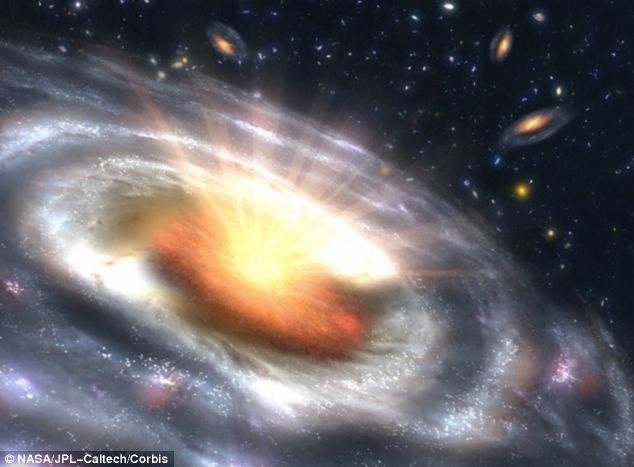
Are we living in a HOLOGRAM? Physicists believe our universe could just be a projection of another cosmos
Holographic principle claims gravity comes from thin, vibrating strings
These strings are holograms of events that take place in a flatter cosmos
According to this theory, everything we experience can be described as events that take place in this flatter location
This is the first time the validity of the model has been mathematically tested
THE HOLOGRAPHIC PRINCIPLE
The holographic principle claims gravity in the universe comes from thin, vibrating strings.
These strings are holograms of events that take place in a simpler, flatter cosmos.
The principle suggests that, like the security chip on your credit card, there is a two-dimensional surface that contains all the information needed to describe a three-dimensional object – which in this case is our universe.
In essence, the theory claims that data containing a description of a volume of space – such as a human or a comet – could be hidden in a region of this flattened, ‘real’ version of the universe.
In a black hole, for instance, all the objects that ever fall into it would be entirely contained in surface fluctuations, almost like a piece of computer memory on contained in a chip.
In a larger sense, the theory suggests that the entire universe can be seen as a ‘two-dimensional structure projected onto a cosmological horizon’ – or in simpler terms, a projection.
If we could understand the laws that govern physics on that distant surface, the principle suggests we would grasp all there is to know about reality.
The holographic principle suggests that, like the security chip on your credit card, there is a two-dimensional surface that contains all the information needed to describe a three-dimensional object – which in this case is our universe.
In essence, the principle claims that data containing a description of a volume of space – such as a human or a comet – could be hidden in a region of this flattened, ‘real’ version of the universe.
In a black hole, for instance, all the objects that ever fall into it would be entirely contained in surface fluctuations.
This means that the objects would be stored almost as ‘memory’ or fragment of data rather than a physical object in existence.
In a larger sense, the theory suggests that the entire universe can be seen as a ‘two-dimensional structure projected onto a cosmological horizon’ – or in simpler terms, the universe we believe we inhabit is a 3D projection of a 2D alternate universe.
In a paper posted on the arXiv repository, Yoshifumi Hyakutake of Ibaraki University in Japan calculated the internal energy of a black hole in an attempt provide mathematical evidence for this holographic principle.
In addition to this he explored the boundaries of a specific black hole as well as the effects of ‘virtual particles’, a type of particle that is believed to continuously pop in and out of existence.
In a separate paper, Professor Hyakutake calculated the energy contained inside of the alternate flatter cosmos with no gravity.
Surprisingly, the computer calculations of the theoretical universe and the black hole’s boundaries matched, providing what some say is ‘compelling’ evidence of the dual nature of the universe.
Professor Maldacena has said that the numerical proof that these two seemingly disparate worlds are identical provides hope that the gravitational properties of our universe can someday be explained by quantum theory.
Originally posted 2013-12-13 03:05:51. Republished by Blog Post Promoter

![20131213-040203[1]](https://coolinterestingnews.com/wp-content/uploads/2013/12/20131213-0402031.jpg)












